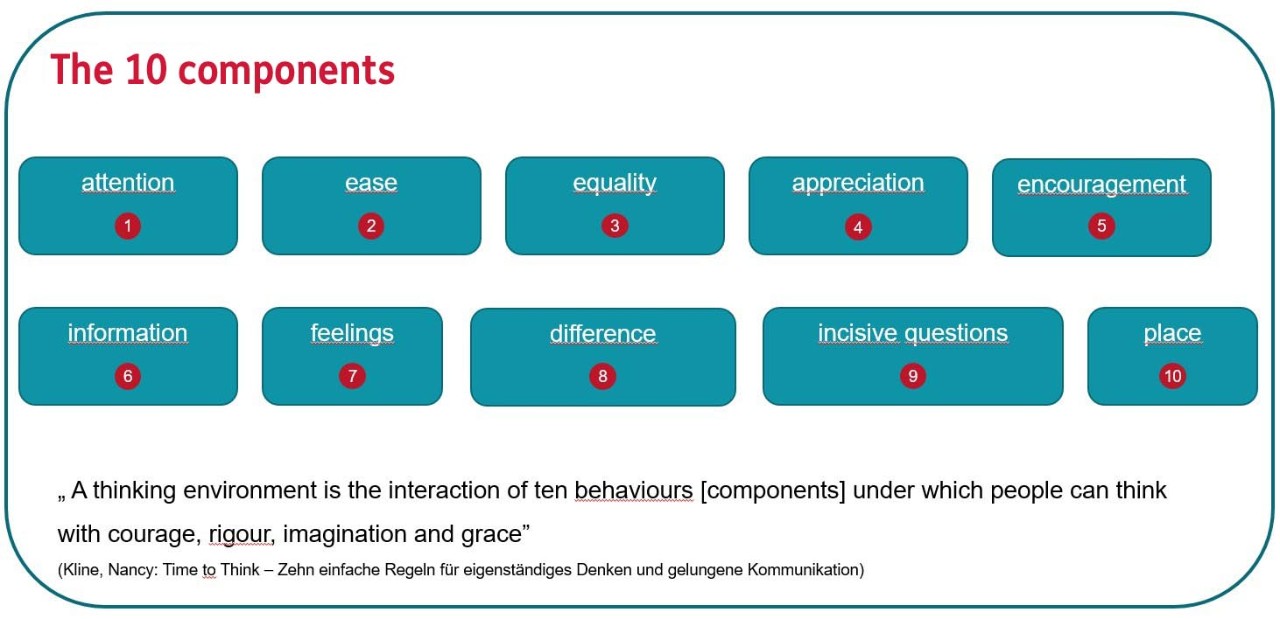Why not bring some new ideas into meeting culture? In two blog posts, we will introduce methods that will make it easy for you to succeed. This article by Julia Limmer is about “Thinking Environment”.

When I first heard the words “Thinking Environment”, I couldn't imagine anything about it. It was only when I experienced such a thinking environment that I became so enthusiastic that I started to look more deeply into the subject.
For me, the idea and the attitude behind “Thinking Environment” is an orientation aid in our togetherness. It shows approaches on how we can deal with the demands that the current working conditions place on us - even more, how we can come up with new thoughts and ideas.
In complex environments, a different kind of thinking is increasingly needed: it is less a matter of reproducing what already exists on autopilot, but rather of thinking one's own thoughts with courage, rigour, imagination and grace.
Every day we find ourselves in many meetings in which decisions are called for, new ideas, alternatives or solutions are sought. In this process, we often fall back on obvious thoughts in our deliberations and statements. We have the feeling that we have to express ourselves quickly, sometimes we even have to fight for our speaking time in order not to get lost in the flow of our colleague's speech. But what does this rapid thinking and speaking do to the quality of our thoughts? And what influence does the quality of our thoughts have on our actions and our decisions and results?
Nancy Kline, founder of the organisation “Time to Think” and the “Thinking Environment”, has been working on the topics of communication and thinking since the 1970s. She has compiled ten components that enable us to create a thinking environment in which we can think independently and freely. A central experience of her studies is: “The quality of everything human beings do depends on the quality of the thinking we do first.” (Kline 2019, p.15).

But do we encounter this thinking environment in our everyday meetings? In our conversations with others? The reality looks rather different. We do a lot of things at the same time: every time slot is used to quickly answer a few emails or we are already thinking about the next meeting. Our attention to what we are doing or the person we are interacting with at that moment is limited. Our thoughts are elsewhere. This creates a feeling of being driven and there is little awareness of our own thoughts and feelings. This limits the quality of our thinking. Real originality in thinking, completely independent thoughts, only arise when we observe our thinking processes and bring them to our consciousness.
The components described by Nancy Kline describe in many points above all our inner attitude as thinkers and as listeners. I would like to take a closer look at four of these components in the following.
I need a listener to think! Excuse me?! Exactly, if you want to create a thinking environment, you need an attentive listener. Someone who follows me with interest and a portion of curiosity while I think out loud. The role of the listener is elementary in the thinking environment: he listens in order to initiate his own, further thinking processes in the other person. The listener does not interrupt the thinker, endures moments of silence and does not evaluate or analyse what is said or react to it. Our conversations tend to be characterised by the fact that we express our thoughts on a topic at the slightest cue. We stick to our point of view, evaluate what has been said and present rather familiar thoughts with our statements. Especially introverts who do not speak up immediately in larger discussions often get lost with their thoughts and thus cannot contribute to advancing the topic.
How would a meeting change if all participants, regardless of hierarchy and role, saw themselves as equal thinkers? If everyone was given equal time to think and speak? If it was not about being the first to say something, to assert oneself?
A certain calm returns. Everyone gets a chance to speak. Views are expressed and heard that inspire the rest of the group to new thoughts. A variety of different (new) thoughts become possible. Equality means giving space for different perspectives and perhaps also contradictory views. Only when all this has found its place can purposeful decisions be made and solutions worked out.
The feeling of haste and urgency permeates our everyday life and our language: we have to do something “quickly” or “just briefly” ask a colleague something. We fill the resulting free spaces with things that we can do quickly. We rarely experience time that is free of haste and urgency. In order to improve the quality of our thinking, however, we need precisely such pauses for reflection. It is not about additional time, but about the inner attitude with which we design our pause for reflection. In practice, for example, it works well if all participants in an appointment can first “arrive”. One or two minutes of silence at the beginning of a meeting are helpful.
A feeling of serenity also comes from knowing that I am not interrupted while thinking. I have time to gather my thoughts and follow my own thought process.
“What compliment have you been happy about in the last few days?” or “What things give us hope in the project, even if we are not on schedule?” - these can be introductory questions in a thinking environment. What happens when we answer the question? We add a positive aspect to our picture of reality by noticing and expressing what is good. This state has been shown to improve the quality of our thinking.
The fourth component, “appreciation”, is also about showing my interlocutors appreciation for their abilities. It is exciting that we can do this even if we hardly know someone or don't particularly like them. The effect of a sincere appreciation of a quality that I have perceived in the other person is immediately noticeable - it feels like a warm shower. The mood is positively charged, relaxed and inspires to think further.
The basics for a thinking environment can be applied to a variety of typical meeting formats in our everyday office life - also in the virtual space.
Try the following in your next team round and observe the change:
Kline, Nancy (2019): Time to think: Zehn einfache Regeln für eigenständiges Denken und gelungene Kommunikation.
Miketta, Marion (2018): Denkräume schaffen in Coaching und Beratung.
Meet-up: Thinking Environment – Denkräume schaffen (Nürnberg, aktuell auch virtuell)
Text: Julia Limmer
Most popular